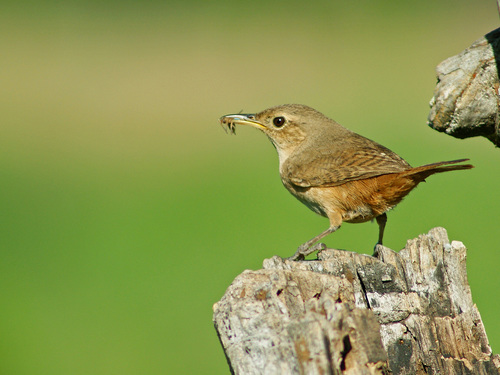
House Wren
The House Wren (Troglodytes aedon) is a small, active songbird common throughout much of the Americas. Known for its energetic and often complex songs, it plays a vital role in controlling insect populations. While not particularly flashy in appearance, its bubbling personality and adaptable nature have made it a familiar backyard bird for many. It holds no particular cultural significance, but its ubiquity and willingness to nest near human habitation have made it a well-studied and generally appreciated species.
11-13 cm
Length
15-17 cm
Wingspan
Least Concern
Conservation Status
Distribution
The House Wren has a wide distribution, ranging from southern Canada throughout the United States and Mexico, extending south into Central America and large parts of South America. Some populations are migratory, with northern birds moving south for the winter. They occupy a broad altitudinal range, from sea level to over 3,000 meters.
Lifespan
The average lifespan in the wild is about 7 years, although individuals living longer have been recorded.
House Wren's Habitat
Habitat Types
Forest edges, Woodlands, Parks, Gardens, Shrublands, Savannas
Climate Zones
Temperate, Subtropical, Tropical
Adaptations
House Wrens are highly adaptable to a variety of habitats, showing a preference for areas with dense undergrowth or cavities for nesting. Their small size allows them to exploit a wide range of nesting sites, from natural tree hollows to man-made birdhouses.
Variations
Numerous subspecies of House Wren are recognized, reflecting geographic variations in plumage color and size. Island populations, in particular, may show distinct characteristics.
Appearance
Breeding Plumage
There is generally little difference between breeding and non-breeding plumage, though breeding birds may appear slightly brighter.
Seasonal Feather Changes
Minor seasonal variations; plumage may be slightly duller after molting.
Sex Based Plumage Differences
Males and females have very similar plumage, making them difficult to distinguish visually.
Notable Features
Plain brown overall with subtle barring on wings and tail., Short, slightly curved bill., Often holds its tail cocked upwards.
Diet and Feeding
Primary Foods
Insects, Spiders, Other small invertebrates
Foraging Behavior
House Wrens actively forage on the ground, in shrubs, and in low tree branches, gleaning insects and spiders from foliage and bark. They are known for their quick, darting movements.
Specializations
Their small size and agility allow them to access insects in tight spaces.
Seasonal Diet Variations
Diet remains largely consistent year-round, although the specific types of insects consumed may vary depending on availability.
Behavior
Social Structure
House Wrens are generally solitary or found in pairs during the breeding season. Outside of breeding, they may be found in small, loose flocks.
Communication
Complex and varied songs, often used to defend territory and attract mates., Sharp call notes used for alarm or communication between pairs.
Migration
Many populations are migratory, with northern birds moving south to warmer climates for the winter. Migration is often nocturnal.
Territorial or Group Behaviors
Males are highly territorial during the breeding season, aggressively defending their nesting area from other wrens and even other bird species. They are known to destroy the eggs and nests of other birds.
Conservation
Threats
Habitat loss and degradation, Pesticide use, Competition with invasive species (e.g., House Sparrows)
Protection Programs
General habitat conservation efforts benefit House Wrens.
Local National Laws
Protected under the Migratory Bird Treaty Act in the United States.
Population Trend
Stable
Population Estimates
Global population is estimated to be around 160 million individuals.
Interesting Facts
House Wrens are known for their aggressive behavior.
Despite their small size, they will fiercely defend their territories and nests, even against larger birds.
Males build multiple nests.
This is part of the courtship ritual, and the female chooses which nest to use.
House wrens will use many differnet locations to nest
They have been seen to use old boots, tin cans and even the pockets of hanging laundry.
Faqs about House Wren
What can I do to attract House Wrens to my yard?
Provide nesting boxes, maintain dense shrubs and vegetation, and avoid pesticide use.
Why do House Wrens destroy the nests of other birds?
This is likely a form of competition for nesting sites, reducing the success of other species that might compete for resources.
Are House Wrens beneficial to have around?
Yes, they are voracious insect eaters and help control populations of many garden pests.
Copyright @ Nature Style Limited. All Rights Reserved.
 English
English